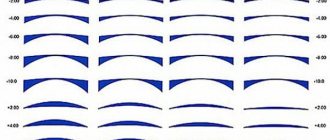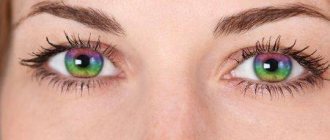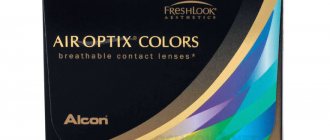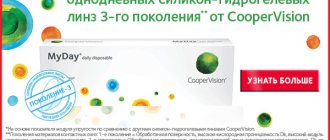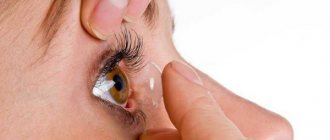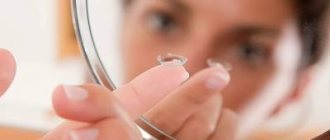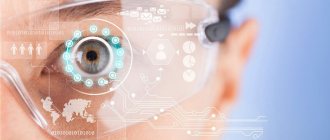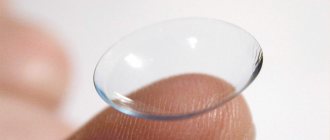More and more people with myopia are choosing contact lenses instead of glasses. The most common reason for this choice is that they are less conspicuous to others. In addition, the person himself practically does not notice them and does not feel discomfort when using them. In ophthalmological practice, various contact lenses have long been used for myopia.
Choosing contact lenses after an eye test
Only an ophthalmologist can help with the choice of any corrective agents. To determine myopia and prescribe lenses, your doctor may use objective or subjective testing methods. Let's figure out what they are.
Objective methods
Some of the most common objective types of vision testing are skiascopy and refractometry.
- Skiascopy uses a thin flat mirror with an internal hole. A beam of light is directed through it onto the eye. By rotating the mirror surface, the pupil is displayed in red or black. It depends on where in the fundus of the eye there is a place that reflects light. The degree of myopia in the patient is determined by the change in color. And based on these results, the necessary lenses are already prescribed.
- Refractometry is a study that determines the speed of refraction (the refractive power of the eye). It is based on studying the position of a luminous mark that is reflected from the fundus of the eye.
Subjective methods
Thumbnail of Sivtsev’s table: click to enlarge
Subjective methods include testing techniques without special and precise equipment.
- Most often, special posters are used for this (Sivtsev’s test table, tables for checking color perception).
- In addition, to identify visual pathologies, small sets of spectacle glasses or phoropters are used - devices with an automated change of lenses in front of the eyes of the person being tested.
Having identified one or another degree of myopia (weak, moderate and severe), the ophthalmologist will draw conclusions and recommend a certain type of lenses based on the material, correction method, wearing period and moisture content.
Indications and contraindications for wearing lenses for myopia
Ophthalmologists distinguish three degrees of myopia: mild (up to 3 diopters), moderate (3-6 diopters) and high (over 6 diopters). Contact lenses can be worn for any degree of myopia. In the initial stages of the disease, they can provide visual acuity of up to 1.0. However, with more severe myopia it is usually not possible to obtain 100% vision. The higher the degree of myopia, the lower the corrected visual acuity.
Indications for contact correction:
- Medical. The need to wear lenses occurs when myopia is combined with other ophthalmological diseases (keratoconus, strabismus, amblyopia, anisometropia, lazy eye syndrome). Doctors recommend wearing them for irregular myopic astigmatism, when it is impossible to correct vision with glasses.
- Professional. Contact correction should be chosen by people in certain professions in which working with glasses is not only inconvenient, but also dangerous. They must be worn by athletes, construction workers, doctors, etc.
- Cosmetic. Some people don't want to wear glasses, so they prefer contact lenses. The desire of a person when choosing a corrective agent in this case is decisive.
Contraindications for wearing products:
- xerophthalmia (dryness of the conjunctiva and cornea), impaired lacrimation;
- the presence of inflammatory processes of the eyelids, conjunctiva, cornea, lacrimal ducts;
- glaucoma in the stage of decompensation;
- displacements (dislocations and subluxations) of the lens;
- bronchial asthma, vasomotor rhinitis and other allergic diseases.
Lenses are not recommended to be worn by people who do not comply with the rules for their storage and use. Improper use of contact correction products can lead to a number of complications. The most common of them are conjunctivitis, keratitis and other infectious and inflammatory eye lesions. Read more about the causes, symptoms and treatment of acute conjunctivitis →
Material
Contact lenses are usually divided into soft and hard. The first ones are made from polymers. And the latter are most often made of silicone, but there is another option. Let's look at them in more detail.
Soft (SCL)
The soft type is very popular among people with diagnosed myopia. They are quite easy to use and comfortable on the eyes. They are made from polymers. This includes, for example, hydroxymethyl methacrylate (HEMA). They are very elastic and gas permeable, making them easy to wear. They fit the cornea (as opposed to rigid ones), which allows them to be standard and mass produced.
Important! Despite all these advantages, SCLs are effective only with a slight disadvantage. This is due to the fact that they closely follow the irregular shape of the cornea. In addition, soft lenses are not as durable as hard lenses and therefore require careful care.
Rigid (ZhKL)
This type is made from either polymethyl methacrylate (PMMA), in which case they are gas-tight, or silicone-based, which makes them gas-permeable. Depending on these components, patients tolerate them differently.
Thus, patients with myopia tolerate PMMA lenses worse than silicone ones. As we already said, they cannot pass oxygen. Accordingly, it is quite difficult to adapt to them. While gas-permeable lenses made from silicone copolymers are much easier for patients to tolerate, because... they allow oxygen to pass through, supplying it to the cornea.
It is important to understand that LCLs must completely match the shape of the cornea and can only be manufactured individually in laboratories.
Difference between soft and hard contact lenses
Nature of correction
- For people who have mild myopia, the spherical shape is best suited. In this case, the lens is convex on only one side.
- The aspheric form is rarely prescribed, usually when any additional pathologies appear. There is a convexity on both sides.
- For people who, during testing, in addition to myopia, also had astigmatism, it is recommended that the toric option be used for vision correction.
- The bifocal shape helps if myopia is complicated by farsightedness (in the same eye).
- If a person has signs of presbyopia (age-related farsightedness), then, as a rule, the attending physician indicates the multifocal form in the prescription. Its essence is in several zones, for near, distance, as well as peripheral vision.
- Perifocal lenses are most often prescribed for myopia. They do not have the main disadvantage of standard ones. When wearing regular lenses, light rays are focused in the center of the retina. Because of this, it is completely impossible to get rid of the visual defect. The perifocal type has the ability to distribute the light load over the entire surface of the retina. That is, in addition to central vision, peripheral vision is involved.
Lens shapes for myopia: click to enlarge
Top 6 best daily lenses
Soflens Daily Disposable
The products are reasonably priced and do not require daily maintenance. With the help of these lenses, it is possible to provide perfectly clear vision, regardless of the time of day. This is achieved through the use of improved optics. The manufacturer does not recommend sleeping in them, as this can ultimately lead to discomfort and serious pain. These products were created specifically to correct spherical aberrations across the entire diopter range in real time. The lenses prevent ghosting and glare. The quality of vision is significantly improved.
More: Top 10 best pills for high blood pressure, how to choose a medicine for hypertension
The lenses are very comfortable to put on and wear – the manufacturer recommends using them for a maximum of 16 hours. They are produced on the basis of non-ionic hydrophilic material. Even if the cornea secretes various lipid and protein substances, the lenses will not be sensitive to these compounds - this provides additional comfort while wearing. The lenses are packaged in original blisters that are very easy to open. The products themselves are flexible and elastic, so they are easy to put on even for people who have just started using lenses.
Advantages:
- Aspherical design;
- Provides protection from ultraviolet rays;
- Excellent optical performance;
- Acceptable cost of products;
- Can be worn for a long time.
Flaws:
- Not suitable for every person;
- You will have to get used to them within a few days.
Soflens Daily Disposable
MyDay daily disposable
These contact lenses are manufactured by a world famous American company. They are single use products and must be changed daily. Every morning the user must put on a new pair, and in the evening take it off and dispose of it with household waste. This option is perfect for patients who are susceptible to refractive errors such as farsightedness and myopia. In addition, the lenses reliably protect the cornea from the negative effects of ultraviolet rays - a similar effect was achieved thanks to the use of a special filter. The product is optimally suitable for people whose optical power of the eye is in the range from -10 to +6 diopters.
Lenses are made on the basis of the original material Stenfilkon A. This is a unique polymer composition made on the basis of the latest Smart Silicone technology, thanks to which it is possible to ensure the highest comfort in wearing lenses. The company’s specialists were able to achieve an increased degree of oxygen permeability. There are not too many silicone compounds here, so your eyes will not dry out. The optics themselves have ideal softness and fit well to the cornea, providing the tightest possible contact. One package contains 30 lenses – enough for 2 weeks of regular use.
Advantages:
- Optimal optical characteristics;
- The lenses are made from a very soft and elastic material;
- The products allow a significant amount of oxygen to pass through, which allows the eyes to breathe;
- There is a reliable filter for protection against ultraviolet rays;
- They are absolutely invisible to the eyes.
Flaws:
- The price is significantly higher than average;
- If a person is intolerant to silicone, then the lenses can cause an allergic reaction.
MyDay daily disposable
Dailies Total 1
Many people today often experience the so-called dry eye syndrome, which causes significant discomfort, especially if you use products used for contact vision correction. This product has optimal water gradient properties, which makes it possible to cope well with this problem. The lenses contain a significant amount of moisture, which ensures an optimal feeling of comfort and freshness for a long time - up to 18 hours of continuous wear. The lenses are made using a unique technology based on the ultra-modern material Delefilcon A. It contains about 80% moisture, and it also allows air to pass through it perfectly.
The eyes breathe fully, the likelihood of developing oxygen starvation of the cornea is zero. Many ophthalmologists recommend these lenses for people who are just starting to wear lenses. They are also well suited for consumers suffering from hypersensitivity of the eyes or prone to allergic reactions of various kinds. Despite the fact that the lenses appeared on the global and Russian markets not too long ago, they were able to gain enormous popularity among users. The lenses give your eyes freshness throughout the day; you hardly feel them while wearing them. The surface of the material is ultra-smooth, the likelihood of even microscopic damage to the cornea is reduced to zero. The lenses are absolutely safe for eye health and do not require a long adaptation period.
Advantages:
- They allow a significant amount of atmospheric oxygen to pass to the eyes, preventing the occurrence of corneal hypoxia;
- With the help of lenses, hyperopia and myopia can be corrected;
- Suitable for beginners, as well as for people suffering from allergic reactions;
- Moisturizes eyes well;
- Almost unnoticeable throughout the day.
More: Top 10 best glucometers, which glucometer is better to choose?
Flaws:
- They are quite expensive, but when you purchase a large package containing 180 lenses, the price drops to the average category.
Dailies Total 1
One Touch
They are biocompatible products that are produced on the basis of a unique hydrogel. It is manufactured using a special innovative technology, which makes this material ideally compatible with the surface of the cornea in the vast majority of biological parameters. This solution allows beginners to use lenses comfortably - they will not have to get used to wearing the products, and no discomfort or allergies will arise. It is worth noting that in many people the cornea has increased sensitivity to solutions, the lenses themselves, and so on - when using such products, such reactions do not occur.
The product has an aspherical design, which further improves the quality of vision. The curvature of the surface decreases as the lens moves towards the periphery. Using this approach, it is possible to neutralize or significantly minimize spherical aberrations. The lenses are moistened using a special 3D system, so the feeling of dryness will not occur even in rooms with low air humidity. One of the layers of the lens is a special biocompatible GMA polymer material, with which the product imitates the mucin layer of tears. This technology greatly reduces lens dehydration.
Advantages:
- With the help of these lenses it is possible to combat any manifestations of myopia and farsightedness;
- Made exclusively from hypoallergenic material;
- Allows you to completely get rid of the so-called dry eye syndrome;
- The lenses are equipped with reliable and high-quality ultraviolet filters;
- The cost will be within the means of almost every person, regardless of his level of income.
Flaws:
- Lenses are made from extremely soft materials and should be handled with the utmost care. If a person has long nails or manicure, it is better to use special tweezers.
One Touch lenses
ACUVUE OASYS 1-Day with HydraLuxe
These lenses are manufactured by the world-famous Johnson & Johnson company, which produces not only lenses, but also various types of cosmetics. The products are optimally suited for users with various types of visual impairment, who, due to the nature of their work, have to spend a significant amount of time at a personal computer, laptop, or keep their eyes strained. As a rule, such activity leads to itching, dry eyes, redness, and so on. Using these products is quite convenient, since there is no need to wash them in solution, store them in containers, etc. The lenses are absolutely safe and will not cause discomfort even if you have to wear them for a long time. In the manufacture of such lenses, an original technology was used, called HydraLuxe. This solution gives the product moisturizing characteristics.
More: Top 10 preventative measures to protect against coronavirus
The lenses are supplied in sealed blisters filled with a special solution. The composition of the latter is practically no different from natural tears, which helps to increase comfort during wear. There is no feeling of dryness due to the fact that the lenses form a protective film on the surface of the cornea. It prevents the mucous membrane of the eye from drying out. Lenses are produced on the basis of thiaphilic silicone, which excellently allows atmospheric oxygen to pass through, preventing the development of corneal hypoxia. Absolute clarity of vision returns to a person, regardless of the degree of illumination.
Advantages:
- With the help of such lenses it is possible to correct hypermetropia and myopia;
- The products are characterized by excellent optical qualities;
- Easily allows atmospheric oxygen to pass through;
- During manufacturing it is equipped with reliable and high-quality ultraviolet filters;
- There is an inversion indicator;
- Absolutely colorless.
Flaws:
- Not suitable for people who are allergic to silicone products;
- They are quite expensive.
ACUVUE OASYS 1-Day with HydraLuxe
Miru 1day UpSide
The leaders in our review of daily or disposable lenses were Japanese-made products, which have very high quality and a number of other important advantages. The first thing that catches your eye is the original packaging. It is a small box made of plastic, in which 30 blisters are compactly packed. There is not too much solution in each blister - only about 0.2 ml, so you don’t have to worry about getting wet or staining your clothes. Inside there is a heart-shaped backing made of perforated plastic. This solution is also responsible for hygiene - the user will not touch the inside of the lens when removing the lens from the package.
The lenses are made on the basis of the hydrogel material HEMA-GMA Hioxifilcon, to the structure of which a special component has been added that does not allow moisture to evaporate from the surface of the cornea. Due to the significant moisture content, the lens will additionally lubricate the cornea and the inner surface of the eyelid, providing even greater comfort. The material allows oxygen to pass through itself, allowing the eyes to breathe. Although the lenses are very thin, they are soft and have a very low elastic modulus, so they are comfortable to wear and easy to put on even for beginners.
The lenses are made using Nanogloss™ Pro surface treatment technology, resulting in ultra-smooth lenses. Therefore, they always remain transparent, clean and moisturized. MeniSilk™ Air provides high hydrophilicity and oxygen permeability.
Advantages:
- Passes a significant amount of oxygen through itself - it is enough for full breathing of the cornea;
- Excellent Japanese quality of optical products;
- The original design of the blister ensures the greatest hygiene when donning and using;
- The lenses have a fairly low modulus of elasticity, making them quick to put on and comfortable to wear;
- Reliable protection against the negative effects of ultraviolet rays is provided.
Flaws:
- It belongs to premium quality products and, accordingly, is characterized by a decent price.
Miru 1day UpSide
Wearing time
Among the variety of contact lenses, there are several types, which are divided according to the time of their use:
- One-day.
- Nighttime.
- Two weeks.
- Period.
- Quarterly.
- Annual.
One-day
From the name itself it is clear that they are used only for one day. Their price is quite low, since when correcting vision with such lenses, they must be purchased daily. They are suitable when the main correction tool is glasses, and lenses are worn only in extreme cases, for example, when playing sports.
Night lenses
Their main advantage is that night lenses should be used exclusively at night. They correct the cornea in their sleep and, as a result, the next morning, light reaches the retina correctly and the person sees everything. One of the disadvantages of night lenses is their fragility. They lose the effect that helps in treating vision after the first use. As a result, you need to put on new ones every time before going to bed.
How night lenses work: click to enlarge
Two weeks
This type is the most acceptable, as it combines convenience, price and certain physical properties.
Period
Lenses with this wear duration are best suited for people who need to wear them on a regular basis.
Quarterly
Used during the correction period lasting up to 3 months. They are expensive and require proper care.
Annual
They are prescribed only for a sufficiently long period of use. Sometimes they require replacement earlier, for example, after nine months.
Lens color
Typically, the selection of contact lenses involves choosing only between optical characteristics. However, today you can not only correct your vision, but also change your eye color to suit your mood or suit. Such products can be worn even by those who see well. Only then should the optical power be zero.
Sometimes colored products are worn by people with problems such as:
- multicolor iris;
- lack of pupil;
- sensitivity to solar radiation;
- thorn.
Three options are available:
- Tinted. Lenses only emphasize the natural color without radically changing it.
- Colored. Allows you to completely change the color. It may look natural, but not always.
- Creative. They are worn on occasion to create an unusual look with the eyes of an animal, monster or to create an unusual effect.
Color is applied in two ways:
- on top of the material in a thin layer;
- the coloring pigment is part of the optical material.
The last option is the most preferable, since the paint cannot come off. But if the color you choose is compatible with one-day wear, then a paint applied on top will do. There is no need to use this layer for a long time, because the next day the set will go in the trash.
Moisture contents
There are three categories of lenses, differing in their water content:
- With high - they contain up to 75% water, which is additionally received by the eyes. They are good for people with dry eyes.
- On average, when wearing them, the mucous membrane is saturated with water up to 54%. This is a great option for those with moderate to severe myopia.
- With a low liquid content they can contain up to 40% moisture, and therefore they are rarely prescribed. When wearing this type, additional replenishment of moisture to the organs of vision is necessary.
Other lenses
In addition, even if you are nearsighted, if you wish, you can choose not simple lenses, but colored, tinted or even carnival ones (for special occasions). Let's take a closer look at them.
Colored
Colored contact lenses are used in most cases in which it is necessary to hide visual defects in the organs of vision, as well as to change and emphasize a person’s image.
Tinted
An excellent option for people with light irises. They do not change color, but only create a rich, deep shade. They are not suitable for people with dark irises.
Carnival
They are also called crazy lenses. Most often used to radically change a person. This is an indispensable tool that can be used by people who are interested in theatrical activities and are involved in working in the film industry. They are very popular in show business.
Lens parameters
Before you start using contact lenses, you must consult with an ophthalmologist, who, during examination, will determine the degree of myopathy and examine the fundus of the eye. Lenses made of hard material and night lenses have a therapeutic effect, soft ones are used for correction. To reduce dryness of the eye mucosa, optics with a moisture content of 55% or more are used.
When selecting lenses, the radius of curvature is taken into account, which is determined by the curvature of the human cornea. As a rule, this parameter is 8.6 mm, but taking into account the individual structure of the eye, the figure can vary within 8.3 mm or 8.8 mm. If you choose the right radius of curvature, the optics will not slide across the surface of the eye when blinking or moving.
Otherwise, injuries will occur and irritation will occur.
Terms of use
Once the desired contact lens option has been selected, several rules for their use should be followed:
- Be sure to wash your hands before putting on.
- Use only sterile lenses with a valid expiration date.
- It is strictly forbidden to wear them for more than the prescribed period.
- Under no circumstances should you sleep in them. The exception is nighttime.
To summarize, we can say that if a person is diagnosed with myopia, then only his attending physician can determine what lenses he needs. And the person himself will choose the most comfortable design option for himself.
